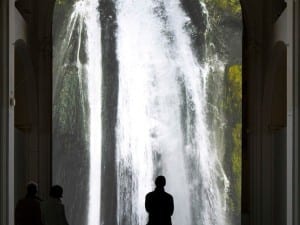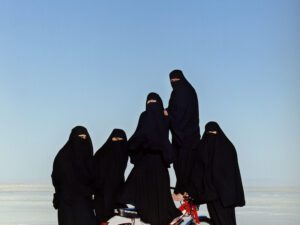Critic and curator Hans Ulrich Obrist said: “In a society full of inequality, we as art institutions, or we in the art and architecture field, need to go to the people, we need to take that obstacle away.” Public art is a way to bring both historical and contemporary art to the whole population, provoking us all to think more deeply about our cities and societies. Permanent sculptures can often come to be synonymous with a location, from Antony Gormley’s iconic Angel of the North (1994) to Edvard Erikson’s The Little Mermaid (1913) or Anish Kapoor’s Cloud Gate (2006). Yet temporary public art installations can draw people to a spot, gathering in a collective moment of curiosity – think of Olafur Eliasson’s Green Rivers series or Christo and Jeanne-Claude swathing archipelagos in 6.5 million square feet of pink fabric on Miami’s Biscayne Bay. Middelheim Museum is a destination for those looking to experience sculpture. It’s exhibitions, both temporary and permanent, place public art at the fore, inviting locals and visitors to Antwerp to step into a world that merges art, nature and the city itself.

Sculptures and installations have a unique ability to create a sense of place. Middelheim’s ambitious collections, Art in the City and Art in the Park, both root visitors in the history and environment of Antwerp. Journalist Katy Hessel wrote in The Guardian: “public art requires us to be present, to bring it to life with our imaginations, to think about how it was constructed, what its location looked like before and how the art ties in with what already exists – all tools we can use for dreaming up a better world.” It is not difficult to see these principles shine through at Middelheim. Art in the City is comprised of sculptures and installations of local social and historical significance. The art is part of the city itself, available to view at any time, giving its location texture and cultural resonance. The visibility of the works themselves, which include sculptures of renowed painters like Rubens and Teniers, and writers such as Paul Van Ostaijen, mean that it is perfectly placed to instigate public debate and discussion.
Art in the Park, meanwhile, prompts quiet reflection on the relationship between humanity and nature. Based across 30 acres in the Middelheim Nachtegalen Park, it asks vital questions about the relationship between modern life and the environment. One of the artists featured is Richard Deacon (b.1949), whose impressive steel sculpture stands gleaming in the grass. When it initially arrived at the museum in 1993, it was made of wood but it was soon realized that the material would not withstand the Belgian weather. It was decided to recreate the work out of stainless steel, with the piece being titled Never Mind. Not only does the name reflect the idea of moving past mistakes or setbacks, but it also highlights how an artwork is experienced by both the mind and the body. Also on display, Bruce Nauman’s (b.1941) Diamond Shaped Room with a Yellow Light (1986-1990/2018) forces visitors to confront the unsettling side of nature. It is deliberately built along a path, the glowing doorway a clear invitation to enter. But the hospitality is limited, as the low doorway and exposure to the elements create a feeling of discomfort. The artist refers to these works as ‘situations’ or ‘experiences’ rather than ‘objects’, as they explore urban imaginations of untamed nature as somewhere you can encounter monsters.

The museum’s summer exhibition, COME CLOSER, blurs the boundaries between sculpture and performance art. The works make room for new relationship between art and audience, pushing the boundaries of where a piece begins and ends. Sara Weyns, Director of the Middelheim Museum said: “The installations and performances in this exhibition invite you to make choices, just like we do in daily life. Do we pass each other by, or do we engage in conversation? Do we reveal ourselves, or do we keep something in reserve? COME CLOSER is a playful invitation to step out of our role and try out a new one.” Each artist on display encourages viewers to leave their inhibitions behind and involve themselves in the creation process. Joan Jonas’s Mirror Piece I & II (1969, 2018) sees fifteen women hold tall, narrow mirrors as they move in slow patterns. They turn towards the spectators, who see themselves looking back in one mirror, then another. The performers literally present the audience with a looking glass, creating both a sense of distance and connection. Elsewhere, Roger Hiorns’ A Retrospective View of the Pathway (2024) sees two heavy industrial vessels emit a fun foamy bubble. It invites visitors to engage their sense, touch and smell the surroundings. The self-producing sculpture keeps reinventing itself. There is no visible artist involved, and the work is unpredictable – the only question is whether people choose to dive in and engage their sense of childlike wonder. Each artist provides an unfinished piece, using the museum as a space to continue the evolution of their art with the involvement of others.
COME CLOSER runs until 29 September | middelheimmuseum.be
Words: Emma Jacob | In partnership with Visit Flanders

Image Credits:
Joan Jonas, Mirror Piece I & II, 1969/2018. © The Artist / ARS & Amanda Wilkinson Gallery.
Bruce Nauman, Diamond Shaped Room with Yellow Light, 1986 – 1990/2018. © SABMA Belgium 2023. Photo: Tom Conille.
Richard Deacon, Never Mind, 1993-2017. © The Artist.





